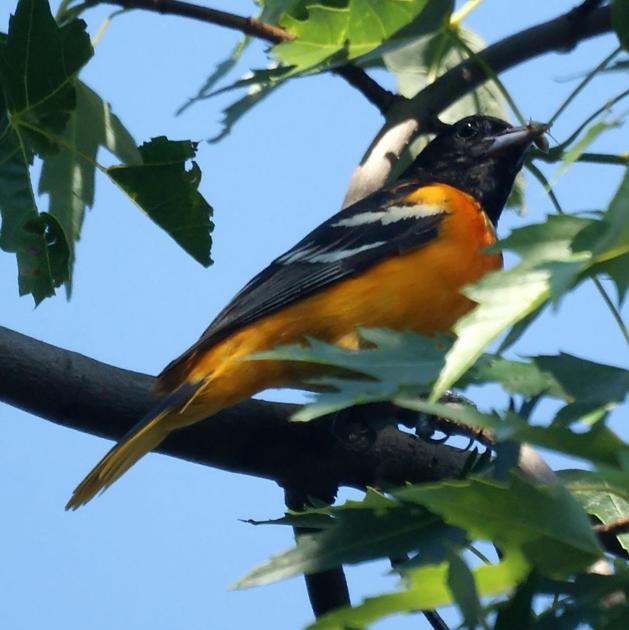
A Baltimore oriole flew to a bird feeder outside my dining room window one morning last month as I was eating breakfast and watching the birds of course.
It was a male, head and upper back black, rump or lower back, breast and outer corners of his tail orange, as bright as the early morning sun. A second oriole followed, a much duller colored bird, a female, head and upper back and tail streaked brown.
American colonists named this bird, and other American orioles, after a beautiful, brightly colored European bird. There are several species of oriole in North America but the Baltimore has the widest range, from the East Coast to the West Coast and from southern Canada to the Gulf of Mexico, excluding, surprisingly it seems to me, Florida and most of Georgia.
Other species of oriole in North America, all of limited range, are Scott’s, orchard, Audubon’s, hooded, streak-backed and Altamira. There is another oriole in North America, now considered a subspecies of the Baltimore, but at one time it was considered to be one with the Baltimore. At that time the two together were called Bullock’s oriole.
As for the name Baltimore, colonists in Maryland gave the bird that name to honor Cecil Calvert, Lord Baltimore, who had come to the new world and lived in Maryland. Calvert’s family colors were the colors of the bird, orange and black.
The Baltimore oriole has been called golden robin as well, and fire-bird and English robin. For its nests it has also been called hang-bird, hang-nest and hammock-bird. Its nest is a cup shaped basket hanging on the end of a small branch of an elm or other large mature tree.
The female oriole makes the nest without assistance from her mate. She begins by making a cradle of strands of grass and horse hair if hair is available. She will also use pieces of string and yarn bits of paper if they’re available. Into the cradle she weaves more grass and other vegetation, and sometimes more paper, making a sturdy cup, the bottom molded to the shape of her body. In this cup, she lays four to six eggs.
A male, the nest builder’s mate, remains in attendance as the female makes the nest but the only assistance he gives is to occasionally bring the female a piece of string or paper. He continues to stick around after the eggs are laid. He does not do any incubating.
It was last month, May, when I saw the orioles at my bird feeders.
I was delighted to see these brightly colored birds of course, but not just for their beauty. Robins and mourning doves are early spring migrants, a sign of spring. Orioles are late migrants which makes them a sign of summer.
Baltimore orioles are also welcome because of their diet, their principal food, insects. They eat some fruit too. After seeing the orioles at our feeders my daughter cut up and put out slices of an orange. Baltimore orioles are also attracted to grape jelly. I was surprised to see the orioles outside our window also land on our hummingbird feeder and appear to take a few sips.
Baltimore orioles migrate through the southern states of the U.S. at about the time cotton boll-weevils are making their annual flight. The orioles feed extensively on these destructive insects. Caterpillars make up much of Baltimore orioles food in the spring. But they also eat plant and bark lice, tiny pests that are overlooked by most birds. They eat ants, too, particularly in the late spring and early summer. They eat the larvae of click beetles which are as destructive as boll-weevil larvae. They eat grasshoppers, wasps and spiders.
The fire-birds only came to my window three days. Then they were off, searching for insects I presume.
"bird" - Google News
June 03, 2020 at 11:00AM
https://ift.tt/2MqanvD
5 birds outside my window | Albion New Era - KPCnews.com
"bird" - Google News
https://ift.tt/2s1zYEq
https://ift.tt/3dbExxU
Bagikan Berita Ini














0 Response to "5 birds outside my window | Albion New Era - KPCnews.com"
Post a Comment